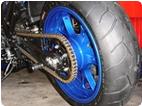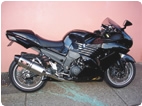"Well, I am thinking how nature will fill a void, no more or no less is the even or the constant 14.7 on the close. Now, is that same air all condensed cold and could expand the pressure? Yes, I think once you heat the air, this is your stoic. Therefore, every close is a neutral 14.7 where you do not even hear a pop on the close because it is that neutral at speed."
Yes, nature would fill a void to atmospheric pressure, about 14.7 psi absolute pressure. But when you try to fill a void at a very fast pace this is not the case. Especially when you are restricting the air passage with a closed throttle. Even at WOT an engine does not run at 100% volumetric efficiency.
"http://www.youtube.com/user/YoshimuraUSA#p/u/5/APq5jz4T_08 Here is an example of the air moving in proportion with the fuel. So, I would think the same fuel would be moving out if the rpm was sustained at half throttle. Would that not be the same fuel no matter what rise and we sustain that throttle now, there is the same 14.7 ratio moving in. What changes the stoic are the fuels. Thus the air to fuel ratios. One fuel will run a totally different stoic we use alcohol, meth, or other exotic fuels."
That is a carburetor. Sounds like a nice design idea for a jet system. The fuel that enters the airstream in a carburetor is based on engine vacuum and the size of the jet. If you have a jet that is too large, too much fuel will flow in, and it will not be stoic.
"Now if you want to talk about forced induction and a rise in air pressure, then I will not argue. But a normally aspirated, if you look at a slow-mo stroke, then it is in the same proportion at speed. Or say if there was 9 pounds of pressure we open the throttle? Would that not suck the piston up the cylinder wall we are not in the neutral 14.7 on the close?"
Only talking natural breathing.
"I have video that shows half the picture screen as normal, the other half in a shadow. That is a natural phenom and if I could find the notes the Boeing engineer drew out, we in nature have this wave that split all 50/50. That is why the guy explained the alpha-arch of the TPS? I think that was meant using the method without the TPS. So, what arch is he talking about was the analog in the TPS. This has nothing to do with the method of a-N. It is what the backup does when the analog fails is the math method-ing the 1Atmo without analog sensors."
Limp mode relys on a-N, 'a' being throttle position and N being RPM. Yes, it assumes all other values.
"But what he neglected to point out and I agree, you can write volumes about one segment of FI, but there is this split of that wave, where fuel injection has to make a transition from D-J to a-N so it works as it does. It had to follow that math of the 60hz split is all I can remember? If I could find an old video, I have that paper with that line that shows the split of the hertz. It's pretty easy if I only could remember the technical part of it."
In other words, what we have [60mhz] as fuel breaks, are the a-N and the D-J. This method is used for low to mid is the D-J part of the hertz signal. The mid to WOT signal is the a-N method(s). This split in the wave of the phenom has to follow the same principal as that injector timing not to spray on a closed valve but the one about to open on that 1/2 stroke. One reason you have 8 injectors for a 4-cylinder engine is that split transition of the 50/50 hertz ratio I was conveying."
I think the system he was referring to is different than ours. Our engines only have 4 injectors, or at least my 06 does. A typical engine will only have 1 injector per cylinder. Some new bikes, and maybe some cars are starting to run 2 injectors per cylinder. I don't know the specifics of these systems, but it's my understanding that one set of injectors are lower flow, and more efficient at lower RPMS, and the other set are high flow injectors for the higher RPMs. Maybe he was saying that the low set work on D-J? (speed density?) and the high flow work on a-N, and he was talking about the transitioning between the sets. But that is not the system we have in our bikes.
"So, would you agree we are in a constant 14.7 on the close but that air temp calls the the volume of air being either hot lean or condense cold = 14.7 psi on the close. No more or no less pressure or that carb bell would be spitting back at the camera lens we were over pressured say. So, are we on the same page yet about FI function is so complex yet so easy to understand even with very few fundamental basics like the 50% split is your half of the way the engine runs in FI and my interpretation of function?"
The IAP (usually called a MAP sensor in cars) is used to measure the presure (vacuum) on the engine side of the throttle plates. This is basically the amount of pressure that is entering the engine, not the 14.7.
With your theory, the same amount of air enters the engine, with the same amount of fuel, no matter what the throttle opening is? then what's keeping the engine from always revving up?










